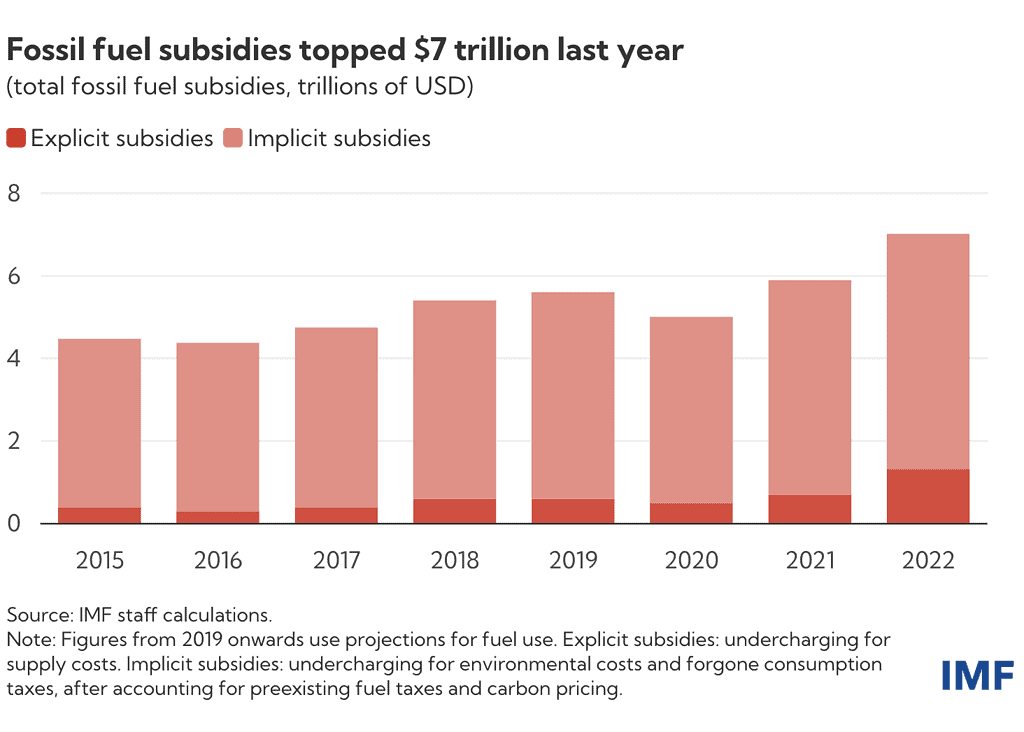Global fossil fuel subsidies reached $7 trillion in 2022 as the government supported consumers and businesses amid the global increase in energy prices caused by Russia’s invasion of Ukraine and the economic recovery from the pandemic. This is equal to $13 million spent on polluting coal, gas, and oil every minute.

The International Monetary Fund (IMF) estimates that fossil fuel subsidies are costing over 7% of the global domestic product – more than that governments spend every year on education and about two-thirds of what they spend on healthcare. The findings come as the world experienced its hottest July on record and emissions continue rising.
Subsidies rose by $2 trillion over the past two years, the IMF said, while explicit subsidies (what governments pay directly to keep energy prices artificially low) have more than doubled since 2010 to US$1.3 trillion. Their new paper provides updated estimates for 170 countries for explicit and implicit subsidies (the environmental cost).
“Consuming fossil fuels imposes enormous environmental costs—mostly from local air pollution and damage from global warming. The vast majority of subsidies are implicit, as environmental costs are often not reflected in prices for fossil fuels, especially for coal and diesel,” the IMF said in a blog post, announcing the study’s main findings.
The largest subsidizers were China, the US, Russia, the EU, and India, the IMF said. Coal was especially subsidized, with 80% of it sold at less than half its true cost.
The estimate of the total fossil fuel subsidies in 2022 would have been almost double if the researchers had used higher climate damage costs that were recently published.
Tackling fossil fuel subsidies
The G20 countries, which cause 80% of the world’s polluting emissions, pledged to phase out “inefficient” fossil fuel subsidies in 2009. However, this hasn’t happened — and if anything, the opposite is true. In 2022, the G20 countries collectively spent US$1.4 trillion on subsidies, according to a report by the Institute for Sustainable Development, a think tank, published earlier this month.

In its report, the IMF asked countries to end fossil fuel subsidies to put the world on track to limit global warming to 2 degrees Celsius, a goal included in the Paris Agreement on climate change. Scrapping subsidies would prevent 1.6 million premature deaths annually, address social inequalities, and raise government revenues by US$4.4 trillion.
However, removing subsidies can be tricky, the IMF acknowledged. For consumers, doing so raises the price of energy. And when this happens, the cost of goods and services also goes up. Opposition to such inflation was evident during protests and political unrest in response to gasoline price hikes in Mexico and electricity prices in Morocco.
Production subsidies, those given directly to companies to offset their cost, are protected by powerful lobby groups. In many countries, fossil fuel industries play a big role in the economy and often support political candidates that advance their interests. There’s also the employment factor, as some countries rely on the sector to provide jobs for many.
“Governments must design, communicate, and implement reforms clearly and carefully as part of a comprehensive policy package that underscore the benefits. A portion of the increased revenues should be used to compensate vulnerable households for higher energy prices,” the IMF said in a blog post.
The full report can be accessed here.









